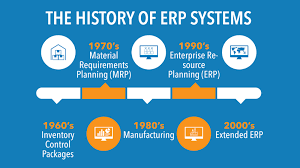The Evolution of ERP Systems: Past, Present, and Future
Introduction
Enterprise Resource Planning (ERP) systems have become integral to modern business operations, enabling organizations to integrate and streamline various processes such as finance, human resources, supply chain, and more. The journey of ERP systems from their inception to their current state is marked by significant technological advancements and changes in business needs.

The Past: Origins and Early Development
The origins of ERP systems can be traced back to the 1960s with the advent of Material Requirements Planning (MRP) systems. These early systems were designed to manage manufacturing processes, primarily focusing on inventory control and production planning. By the 1970s, MRP systems had evolved into Manufacturing Resource Planning (MRP II), which expanded to include additional functionalities such as shop floor control and quality management.
The 1980s and 1990s saw the emergence of the first true ERP systems as businesses sought to integrate their disparate systems into a single, unified platform. Companies like SAP, Oracle, and JD Edwards were pioneers in this space, developing comprehensive solutions that covered a wide range of business functions. These early ERP systems were typically installed on-premises and required significant investment in hardware and IT resources.
The Present: Cloud and Modern ERP
The 2000s brought about a major shift in the ERP landscape with the rise of cloud computing. Cloud-based ERP systems offered businesses greater flexibility, scalability, and cost savings compared to traditional on-premises solutions. Companies no longer needed to maintain expensive hardware and could access their ERP systems from anywhere with an internet connection. This democratization of ERP technology made it accessible to small and medium-sized enterprises (SMEs) that previously couldn’t afford the high costs of implementation.
Today, ERP systems are more advanced and feature-rich than ever before. Modern ERP solutions leverage technologies such as artificial intelligence (AI), machine learning, and the Internet of Things (IoT) to provide predictive analytics, automate routine tasks, and enhance decision-making capabilities. Additionally, these systems are increasingly modular, allowing businesses to adopt and scale specific functionalities as needed without overhauling the entire system.
The Future: Emerging Technologies and Trends
Looking ahead, the future of ERP systems will likely be shaped by several emerging technologies and trends. AI and machine learning will continue to play a pivotal role in automating processes, predicting outcomes, and personalizing user experiences. As businesses generate more data, ERP systems will increasingly incorporate advanced analytics and big data capabilities to provide deeper insights and drive strategic decision-making.
Blockchain technology also holds promise for ERP systems, particularly in areas such as supply chain management, where transparency and traceability are critical. Blockchain could enable secure and tamper-proof transactions, ensuring the integrity of data across the entire supply chain.
Another trend to watch is the growing importance of mobile and remote access to ERP systems. As remote work becomes more prevalent, ERP vendors will need to ensure that their solutions are fully accessible and functional on mobile devices, allowing users to manage business operations from anywhere in the world.
Conclusion
The evolution of ERP systems reflects the changing needs and technological advancements of the business world. From their origins as basic inventory management tools to their current role as comprehensive business management platforms, ERP systems have continuously adapted to meet the demands of modern enterprises. As technology continues to evolve, ERP systems will remain a critical component of business strategy, enabling organizations to stay competitive and agile in an increasingly complex and dynamic environment.